hillbilly1
Senior Member
- Location
- North Georgia mountains
- Occupation
- Owner/electrical contractor
Had a strange one the other day, LED highbays off a 100 amp temporary. Four circuits with four GFI’s. Two on one leg, two on the other. Chop saw on a 100’ 12 gauge cord on one circuit, Five 240 watt LED’s on the another 100’ 12 gauge cord. As soon as the chop saw is started, the gfi for the LED’s trips. Moved the LED’s to another circuit, still does the same thing, moved to the third circuit same thing. Trips about 90% of the time regardless of which leg or circuit it’s on. No voltage drop detected at receptacle using a Fluke 89. Fixtures are rated for 100-277 volts, running on 120 volts. Maybe a spike caused by the saw? Haven’t had that sort of problem before.


